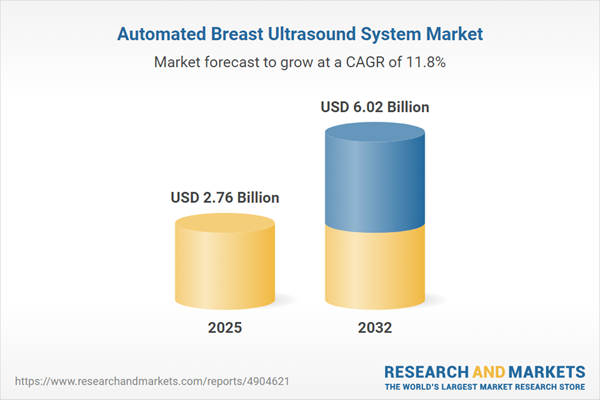Speak directly to the analyst to clarify any post sales queries you may have.
The automated breast ultrasound system market is progressing rapidly, shaped by technological advancement, changing clinical needs, and evolving policy environments. For healthcare stakeholders, understanding market evolution and the strategic levers for competitive advantage has never been more pivotal.
Market Snapshot
The Automated Breast Ultrasound System Market grew from USD 2.47 billion in 2024 to USD 2.76 billion in 2025. It is expected to continue growing at a CAGR of 11.75%, reaching USD 6.02 billion by 2032.
Scope & Segmentation of the Automated Breast Ultrasound System Market
- Product Categories: Display units, system units, transducers, consulting services, maintenance, training, analysis software, integration software, reporting software.
- Application Areas: Diagnostic evaluation, research, screening, treatment monitoring.
- End Users: Diagnostic centers (breast imaging centers, outpatient imaging centers), hospitals, specialty clinics (breast cancer clinics, women’s health clinics).
- Imaging Techniques: Three-dimensional ultrasound (real-time 3D, static 3D), two-dimensional ultrasound.
- Geographic Coverage: Americas (United States, Canada, Mexico, Brazil, Argentina, Chile, Colombia, Peru); Europe, Middle East & Africa (United Kingdom, Germany, France, Russia, Italy, Spain, Netherlands, Sweden, Poland, Switzerland, United Arab Emirates, Saudi Arabia, Qatar, Turkey, Israel, South Africa, Nigeria, Egypt, Kenya); Asia-Pacific (China, India, Japan, Australia, South Korea, Indonesia, Thailand, Malaysia, Singapore, Taiwan).
- Leading Companies: General Electric Company, Siemens Healthineers AG, U-Systems Inc., Hitachi Ltd., Fujifilm Holdings Corporation, Samsung Medison Co. Ltd., Koninklijke Philips N.V., SonoCiné SAS, Elesta S.p.A., Hologic Inc.
Key Takeaways: Strategic Insights for Decision-Makers
- Automated breast ultrasound systems help standardize imaging quality and reduce operator dependency, improving reproducibility and diagnostic confidence across clinical settings.
- Artificial intelligence integration and advanced volumetric imaging are enhancing early detection capabilities, especially for patients with dense breast tissue.
- Connected system architectures and cloud-native solutions support seamless data sharing, enabling health systems to optimize workflows and achieve better clinical outcomes.
- Modular system designs allow scalable investment, permitting healthcare providers to upgrade as needs or budgets evolve without significant infrastructure overhaul.
- User-centered workflows and automated quality assurance features are decreasing training time, lowering the barrier for adoption in various medical environments.
Tariff Impact: Navigating New U.S. Trade Policies
Recent U.S. tariff structures have prompted manufacturers to reconsider global procurement and shift toward domestic production sites. Higher import duties on components are influencing sourcing strategies, product pricing, and supply chain resilience, along with fostering service innovation—such as enhanced maintenance agreements and remote diagnostics. These adjustments are designed to buffer against cost escalations while addressing end-user demand for flexible, long-term support.
Research Methodology & Data Sources
The findings in this report are based on structured interviews with radiologists, medical physicists, and procurement professionals, combined with analysis of peer-reviewed journals, regulatory filings, trade press, and proprietary databases. Analytical methods such as SWOT, value chain evaluation, and scenario analysis were rigorously applied to produce an unbiased, actionable market perspective.
Why This Report Matters for Strategic Planning
- Enables senior leaders to benchmark product, technology, and service strategies against evolving market standards.
- Supports informed decisions by synthesizing clinical, operational, and regulatory trends across major world regions and key industry players.
Conclusion
This report clarifies the evolving landscape of the automated breast ultrasound system market, equipping stakeholders to navigate ongoing technological, operational, and policy-related shifts. Leveraging these insights ensures stronger positioning and improved patient outcomes in a competitive, innovation-driven sector.
Additional Product Information:
- Purchase of this report includes 1 year online access with quarterly updates.
- This report can be updated on request. Please contact our Customer Experience team using the Ask a Question widget on our website.
Table of Contents
3. Executive Summary
4. Market Overview
7. Cumulative Impact of Artificial Intelligence 2025
List of Figures
Samples

LOADING...
Companies Mentioned
The key companies profiled in this Automated Breast Ultrasound System market report include:- General Electric Company
- Siemens Healthineers AG
- U-Systems, Inc.
- Hitachi, Ltd.
- Fujifilm Holdings Corporation
- Samsung Medison Co., Ltd.
- Koninklijke Philips N.V.
- SonoCiné SAS
- Elesta S.p.A.
- Hologic, Inc.
Table Information
| Report Attribute | Details |
|---|---|
| No. of Pages | 190 |
| Published | October 2025 |
| Forecast Period | 2025 - 2032 |
| Estimated Market Value ( USD | $ 2.76 Billion |
| Forecasted Market Value ( USD | $ 6.02 Billion |
| Compound Annual Growth Rate | 11.7% |
| Regions Covered | Global |
| No. of Companies Mentioned | 11 |









